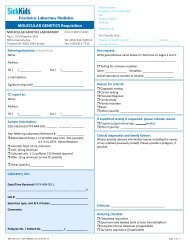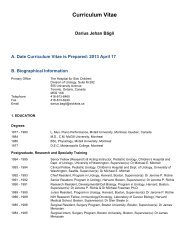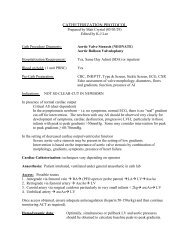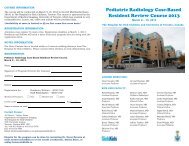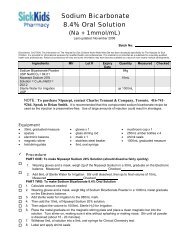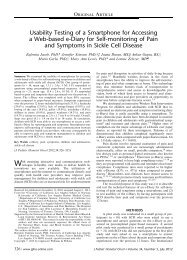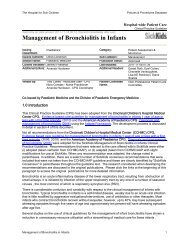Stress, neurotrophic factors <strong>and</strong> depression S213 First of all antidepressants can regulate the HPA axis, whose function is altered in <strong>stress</strong> <strong>and</strong> <strong>mood</strong> <strong>disorders</strong>. Indeed, it has been found that different <strong>stress</strong>ors decrease glucocorticoid receptor (GR) levels in the hippocampus (Chen et al., 2008; Meyer et al., 2001), while antidepressant treatment can up-regulated their expression (Przegalinski <strong>and</strong> Budziszewska, 1993). Moreover, antidepressant treatment is able to alter the <strong>stress</strong> responsiveness in term of translocation of glucocorticoids receptors from the cytoplasm to the nucleus. We demonstrated that chronic antidepressant treatment increase the nuclear GR levels after an acute <strong>stress</strong> (Molteni et al., 2009a), in accordance with a previous study showing that antidepressant increase dexametasone-induced GR traslocation (Pariante et al., 1997). In a recent study it has been shown that chronic treatment with different antidepressants normalizes hippocampal alterations of GR levels due to prenatal manipulation (Szymanska et al., 2009). Moreover, the levels of FKBP51, a GR co-chaperon that retains GR in the cytoplasm, are restored in the prefrontal cortex of the same animals. These results suggest that GR <strong>and</strong> FKBP51 may represent key molecules in the alteration of HPA axis seen in depressed patients. Alterations of GR expression <strong>and</strong> function have also been reported in human cells <strong>and</strong> some of these changes may be normalized by antidepressant treatment (Carvalho <strong>and</strong> Pariante, 2008). While the studies mentioned above suggest that prolonged treatment with antidepressant drugs have a positive impact on neuronal <strong>plasticity</strong>, an important point is to underst<strong>and</strong> if <strong>and</strong> how antidepressants could correct <strong>stress</strong>-induced modifications or, eventually if they may alter <strong>stress</strong> responsiveness. With regard to the first issue, it has been demonstrated that antidepressant treatment can normalize the reduced expression of BDNF following chronic <strong>stress</strong>. For example chronically venlafaxine administration is able to restore BDNF levels <strong>and</strong> neurogenesis that are reduced by after an immobilization <strong>stress</strong> (Xu et al., 2004). Similarly, prolonged treatment with imipramine normalizes behavioural alterations in the chronic social defeat <strong>stress</strong> protocol while restoring reduced levels of the neurotrophin (Tsankova et al., 2006). Both <strong>stress</strong> <strong>and</strong> antidepressant treatment may alter BDNF expression through epigenetic mechanisms. However while prolonged <strong>stress</strong> may repress BDNF transcription through a hypermethylation of histone proteins that lead to a more ‘closed’ chromatin state, chronic imipramine increases H3 histone acetylation in the promoter regions of exon IV <strong>and</strong> exon VI, which may overcome the repressing changes leading to an open chromatin conformation (Tsankova et al., 2006). These studies provide a good example of the possibility that disease-related factors (<strong>stress</strong>) <strong>and</strong> drug treatments may exert their effects on the same protein although not through overlapping mechanisms. Since the concept of neuronal <strong>plasticity</strong> implies that adaptive changes are set in motion in response to ‘external’stimuli, it is expected that antidepressants should not only improve compromised neuronal <strong>plasticity</strong> by affecting the expression of key proteins, but they may also modulate the responsiveness of these systems under challenging conditions. Accordingly, we have recently shown that antidepressant drugs do not only modulate BDNF expression under basal conditions, but can also alter its responsiveness under challenging circumstances. In fact we found that total BDNF expression was slightly increased by chronic duloxetine treatment <strong>and</strong> further enhanced when antidepressant-treated rats were exposed to a short swim <strong>stress</strong> (Molteni et al., 2009a). The antidepressant treatment was able to affect the <strong>stress</strong> modulation of BDNF exon VI, whereas exon IV was regulated by <strong>stress</strong> independently from the pharmacological treatment. Moreover, we found that the subcellular trafficking of the neurotrophin after <strong>stress</strong> was significantly affected by duloxetine treatment. In fact only animals that were chronically injected with the antidepressant showed a significant increase of synaptosomal mBDNF levels when exposed to the acute challenging condition (Molteni et al., 2009a). These data suggest that chronic antidepressant treatment can affect cellular resilience not only by increasing the expression of ‘protective’ proteins, but also by altering the coping ability under potential ‘threatening’ situations. Figure 1 Mechanisms underlying the impact of <strong>stress</strong> or depression on the BDNF system <strong>and</strong> the potential effects of antidepressant drugs. Stress can reduce the expression of the neurotrophin through epigenetic (1), transcriptional (2 <strong>and</strong> 3) <strong>and</strong> translational mechanisms (4). On the other h<strong>and</strong> antidepressant drugs can restore normal levels of the neurotrophin by different mechanisms including: increase histone acetylation or reduced DNA methylation (5) at specific BDNF promoters; increase transcription of different exons (6 <strong>and</strong> 7); elevated synthesis <strong>and</strong> trafficking of BDNF protein (8); stimulation of protein release <strong>and</strong> increase receptor interaction (9).
S214 F. Calabrese et al. 9. Concluding remarks In summary, the data herein reviewed suggest a close <strong>link</strong> <strong>between</strong> <strong>stress</strong>, neuronal <strong>plasticity</strong> <strong>and</strong> major depression. We believe that a putative mechanism through which <strong>stress</strong> can alter the susceptibility to <strong>mood</strong> <strong>disorders</strong> is the modulation of neuroplastic molecules, such as neurotrophins. Accordingly, antidepressant drugs are able to normalize defective mechanisms that sustain the impairment of neuronal <strong>plasticity</strong> <strong>and</strong> can increase neuronal resilience (Fig. 1). The underst<strong>and</strong>ing of these adaptive mechanisms may lead to the identification of molecular targets for the development of novel <strong>and</strong> more effective drugs. Conflict of interest None. References aan het Rot, M., Mathew, S.J., Charney, D.S., 2009. Neurobiological mechanisms in major depressive disorder. CMAJ 180, 305—313. Adachi, M., Barrot, M., Autry, A.E., Theobald, D., Monteggia, L.M., 2008. Selective loss of brain-derived neurotrophic factor in the dentate gyrus attenuates antidepressant efficacy. Biol. Psychiatry 63, 642—649. Aid, T., Kazantseva, A., Piirsoo, M., Palm, K., Timmusk, T., 2007. Mouse <strong>and</strong> rat BDNF gene structure <strong>and</strong> expression revisited. J. Neurosci. Res. 85, 525—535. An, J.J., Gharami, K., Liao, G.Y., Woo, N.H., Lau, A.G., Vanevski, F., et al., 2008. Distinct role of long 3 0 UTR BDNF mRNA in spine morphology <strong>and</strong> synaptic <strong>plasticity</strong> in hippocampal neurons. Cell 134, 175—187. Berton, O., McClung, C.A., Dileone, R.J., Krishnan, V., Renthal, W., Russo, S.J., et al., 2006. Essential role of BDNF in the mesolimbic dopamine pathway in social defeat <strong>stress</strong>. Science 311, 864—868. Berton, O., Nestler, E.J., 2006. New approaches to antidepressant drug discovery: beyond monoamines. Nat. Rev. Neurosci. 7, 137— 151. Bocchio-Chiavetto, L., Zanardini, R., Bortolomasi, M., Abate, M., Segala, M., Giacopuzzi, M., et al., 2006. Electroconvulsive therapy (ECT) increases serum brain derived neurotrophic factor (BDNF) in drug resistant depressed patients. Eur. Neuropsychopharmacol. 16, 620—624. Bramham, C.R., Messaoudi, E., 2005. BDNF function in adult synaptic <strong>plasticity</strong>: the synaptic consolidation hypothesis. Prog. Neurobiol. 76, 99—125. Calabrese, F., Molteni, R., Maj, P.F., Cattaneo, A., Gennarelli, M., Racagni, G., et al., 2007. Chronic duloxetine treatment induces specific changes in the expression of BDNF transcripts <strong>and</strong> in the subcellular localization of the neurotrophin protein. Neuropsychopharmacology 32, 2351—2359. Carvalho, L.A., Pariante, C.M., 2008. In vitro modulation of the glucocorticoid receptor by antidepressants. Stress 11, 411—424. Castren, E., 2005. Is <strong>mood</strong> chemistry? Nat. Rev. Neurosci. 6, 241—246. Castren, E., Voikar, V., Rantamaki, T., 2007. Role of neurotrophic factors in depression. Curr. Opin. Pharmacol. 7, 18—21. Chao, M.V., Rajagopal, R., Lee, F.S., 2006. Neurotrophin signalling in health <strong>and</strong> disease. Clin. Sci. (Lond.) 110, 167—173. Chen, J.X., Tang, Y.T., Yang, J.X., 2008. Changes of glucocorticoid receptor <strong>and</strong> levels of CRF mRNA, POMC mRNA in brain of chronic immobilization <strong>stress</strong> rats. Cell. Mol. Neurobiol. 28, 237—244. Chen, Z.Y., Jing, D., Bath, K.G., Ieraci, A., Khan, T., Siao, C.J., et al., 2006. Genetic variant BDNF (Val66Met) polymorphism alters anxiety-related behavior. Science 314, 140—143. Chiaruttini, C., Sonego, M., Baj, G., Simonato, M., Tongiorgi, E., 2008. BDNF mRNA splice variants display activity-dependent targeting to distinct hippocampal laminae. Mol. Cell. Neurosci. 37, 11—19. Chourbaji, S., Hellweg, R., Br<strong>and</strong>is, D., Zorner, B., Zacher, C., Lang, U.E., et al., 2004. Mice with reduced brain-derived neurotrophic factor expression show decreased choline acetyltransferase activity, but regular brain monoamine levels <strong>and</strong> unaltered emotional behavior. Brain Res. Mol. Brain Res. 121, 28—36. Duman, C.H., Schlesinger, L., Kodama, M., Russell, D.S., Duman, R.S., 2007. A role for MAP kinase signaling in behavioral models of depression <strong>and</strong> antidepressant treatment. Biol. Psychiatry 61, 661—670. Dwivedi, Y., Rizavi, H.S., Conley, R.R., Roberts, R.C., Tamminga, C.A., P<strong>and</strong>ey, G.N., 2003. Altered gene expression of brainderived neurotrophic factor <strong>and</strong> receptor tyrosine kinase B in postmortem brain of suicide subjects. Arch. Gen. Psychiatry 60, 804—815. Evans, S.J., Choudary, P.V., Neal, C.R., Li, J.Z., Vawter, M.P., Tomita, H., et al., 2004. Dysregulation of the fibroblast growth factor system in major depression. Proc. Natl. Acad. Sci. U.S.A. 101, 15506—15511. Fawcett, J.P., Aloyz, R., McLean, J.H., Pareek, S., Miller, F.D., McPherson, P.S., et al., 1997. Detection of brain-derived neurotrophic factor in a vesicular fraction of brain synaptosomes. J. Biol. Chem. 272, 8837—8840. Fumagalli, F., Bedogni, F., Perez, J., Racagni, G., Riva, M.A., 2004. Corticostriatal brain-derived neurotrophic factor dysregulation in adult rats following prenatal <strong>stress</strong>. Eur. J. Neurosci. 20, 1348— 1354. Fumagalli, F., Molteni, R., Calabrese, F., Frasca, A., Racagni, G., Riva, M.A., 2005. Chronic fluoxetine administration inhibits extracellular signal-regulated kinase 1/2 phosphorylation in rat brain. J. Neurochem. 93, 1551—1560. Fumagalli, F., Racagni, G., Colombo, E., Riva, M.A., 2003. BDNF gene expression is reduced in the frontal cortex of dopamine transporter knockout mice. Mol. Psychiatry 8, 898—899. Ghosh, A., Carnahan, J., Greenberg, M.E., 1994. Requirement for BDNF in activity-dependent survival of cortical neurons. Science 263, 1618—1623. Groves, J.O., 2007. Is it time to reassess the BDNF hypothesis of depression? Mol. Psychiatry. 12, 1079—1088 Epub 2007 Aug 14. Review. Heim, C., Plotsky, P.M., Nemeroff, C.B., 2004. Importance of studying the contributions of early adverse experience to neurobiological findings in depression. Neuropsychopharmacology 29, 641— 648. Huang, E.J., Reichardt, L.F., 2001. Neurotrophins: roles in neuronal development <strong>and</strong> function. Annu. Rev. Neurosci. 24, 677—736. Huang, E.J., Reichardt, L.F., 2003. Trk receptors: roles in neuronal signal transduction. Annu. Rev. Biochem. 72, 609—642. Hunsberger, J.G., Newton, S.S., Bennett, A.H., Duman, C.H., Russell, D.S., Salton, S.R., et al., 2007. Antidepressant actions of the exercise-regulated gene VGF. Nat. Med. 13, 1476—1482. Jeanneteau, F., Garabedian, M.J., Chao, M.V., 2008. Activation of Trk neurotrophin receptors by glucocorticoids provides a neuroprotective effect. Proc. Natl. Acad. Sci. U.S.A. 105, 4862—4867. Joca, S.R., Ferreira, F.R., Guimaraes, F.S., 2007. Modulation of <strong>stress</strong> consequences by hippocampal monoaminergic, glutamatergic <strong>and</strong> nitrergic neurotransmitter systems. Stress 10, 227—249. Kim, J.J., Diamond, D.M., 2002. The <strong>stress</strong>ed hippocampus, synaptic <strong>plasticity</strong> <strong>and</strong> lost memories. Nat. Rev. Neurosci. 3, 453—462. Koo, J.W., Park, C.H., Choi, S.H., Kim, N.J., Kim, H.S., Choe, J.C., et al., 2003. The postnatal environment can counteract prenatal effects on cognitive ability, cell proliferation, <strong>and</strong> synaptic protein expression. FASEB J. 17, 1556—1558. Kozisek, M.E., Middlemas, D., Bylund, D.B., 2008. Brain-derived neurotrophic factor <strong>and</strong> its receptor tropomyosin-related kinase



